A quick and easy Instant Pot recipe for an authentic south-Indian lentil and vegetable stew, Sambar. This popular curry is packed with vegetables and finished with a touch of tangy tamarind paste. It comes together in 40 minutes and is best enjoyed with rice, idli, or dosa.
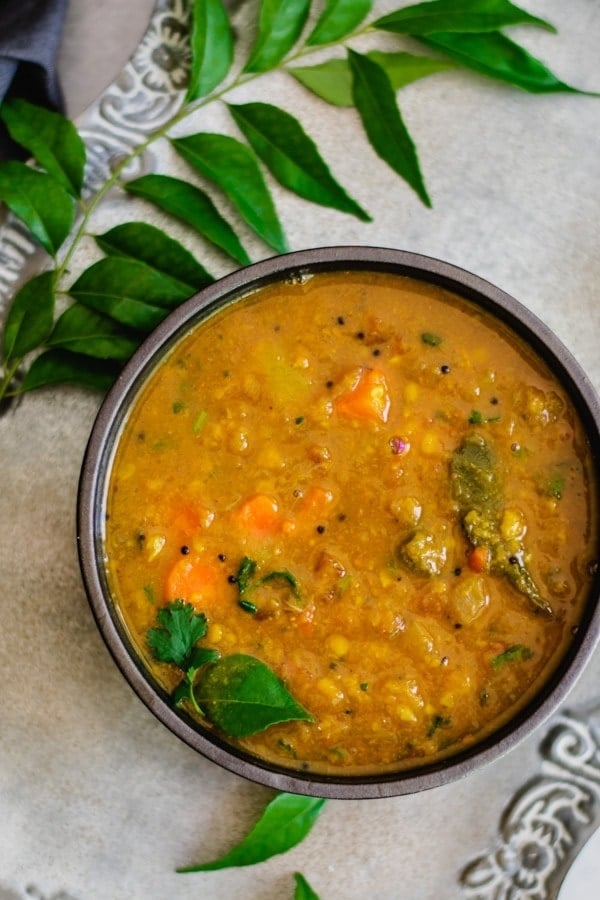
Sambar is a mildly spiced lentil and vegetable stew that is a staple in South Indian cuisine made using split pigeon peas and seasonal vegetables.
Each household has its own spin on the combination of spices and vegetables, which is why the taste and flavor vary between homes.
Growing up, my mom made different variations depending on which seasonal vegetable she had on hand. This is the Instant pot adaptation of my mom's delicious Sambar recipe.
This healthy curry packs in the goodness of lentils and fresh seasonal vegetables in one dish. It also happens to be naturally Gluten-Free, Vegetarian, and Vegan!
Pair it with rice, idli or dosa to sop up all those delicious flavors, and enjoy a hearty and complete meal! It's soul food for me!
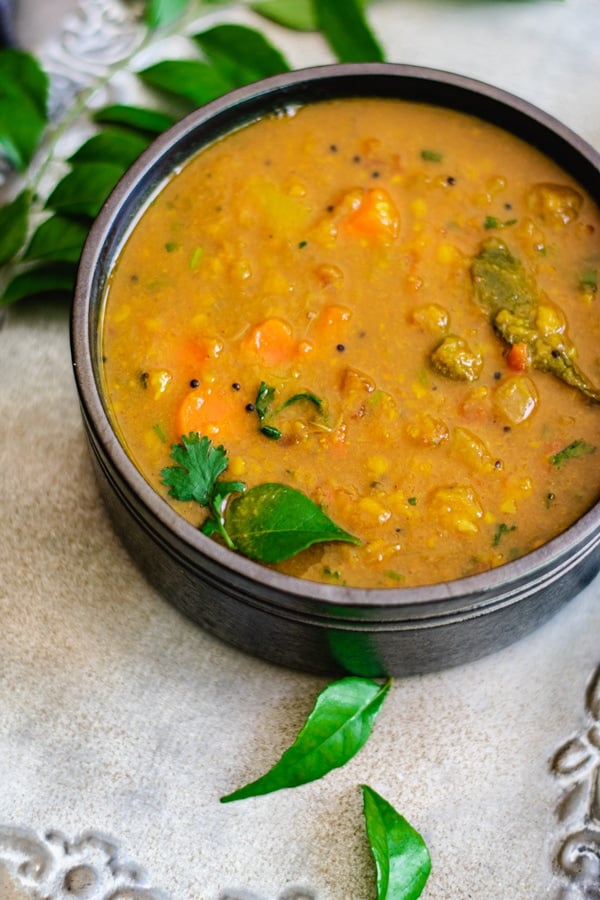
What Is Sambar?
Sambar, or Sambaar, is a South Indian stew made with toor dal (split pigeon peas) and fresh vegetables. It is spiced with a unique spice blend, called Sambar Powder, finished with a tangy tamarind flavor and occasionally sweetened with jaggery.
It is popularly served for breakfast or brunch alongside idli, dosa, vada or Uttapam.
One-Pot Recipe for Sambar
My mom makes Sambar in two steps. She pressure cooks the toor dal, while simultaneously making the onion-tomato masala. Then she adds the masala and vegetables to the cooked dal, adds tamarind and simmers it for a few minutes until the flavors come together.
In this Instant Pot recipe, I use my mom's traditional sambar recipe and cook it in one-step from start-to-finish in the same pot. Mush less effort and only one pot to clean 🙂
I love making lentils & beans in the Instant Pot for the same reason. I can get melt-in-the-mouth textures in very little effort. It works particularly well with Sambar because:
- The gentle heat cooks the lentils perfectly to mash to the right texture.
- Unlike the traditional recipe, there is no babysitting or standing over a hot stove (which I especially love during the summer months).
- This method creates consistent results. It's a super easy recipe my girls and hubby can follow 🙂
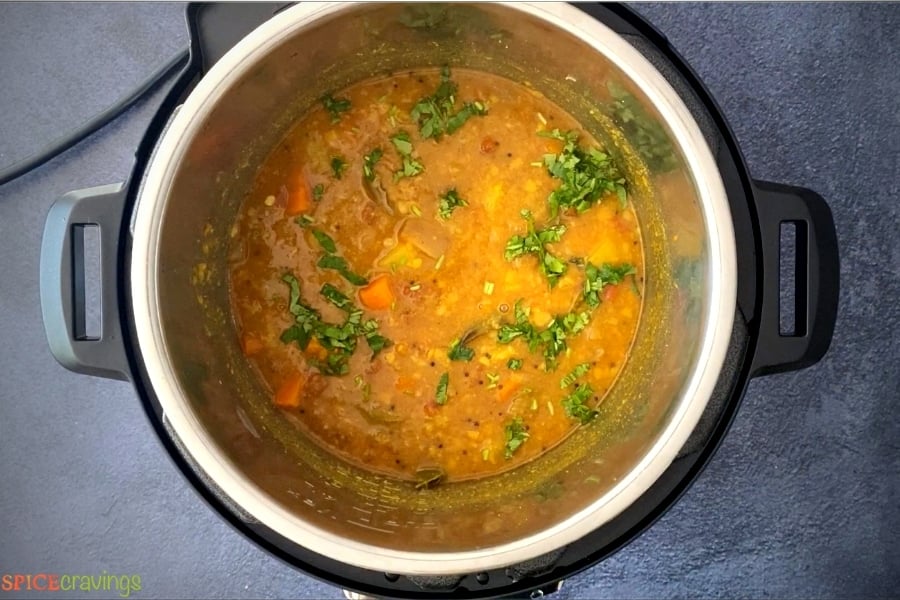
Ingredients, Notes & Availability
The key ingredients needed to make Sambar include toor dal (split pigeon peas), aromatics, vegetables and a special spice blend, called sambar powder. You will also need tamarind concentrate, sugar (or jaggery) and fresh cilantro for the finishing touch. Here are some notes, including popular substitutions:
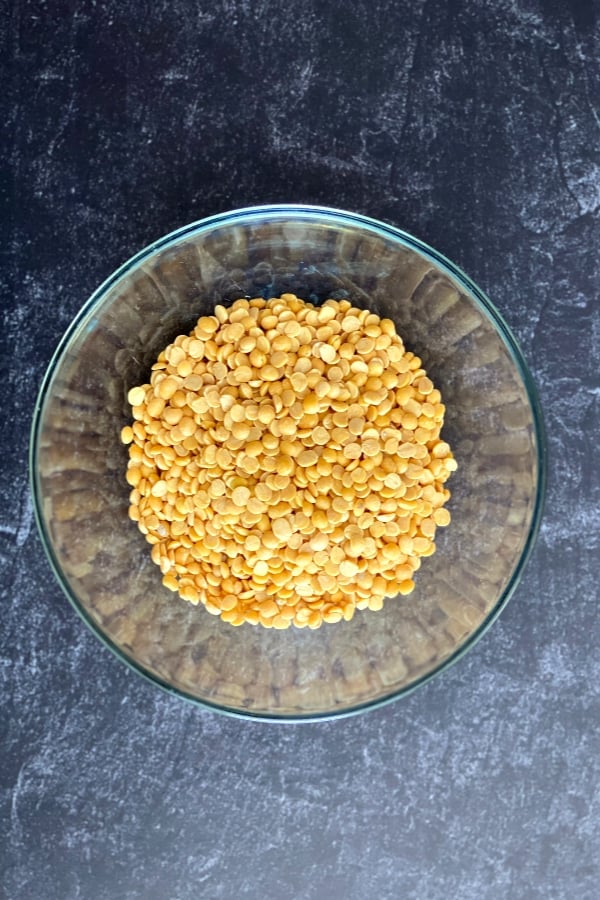
- Toor Dal (Arhar Dal): Also known as split pigeon peas, these are the traditional lentils used to make sambar. There is also the option to use masoor dal (red lentils), but these cook faster than toor dal. If you use masoor dal, adjust the pressure cooking time to 4 minutes.
- Black Mustard Seeds: As with most Indian recipes, we use black mustard seeds here. Black mustard seeds are the most flavorful variety and add a nice tangy- spicy flavor to this recipe. Look for them in Indian grocery stores or online. Tip: Use twice as many yellow mustard seeds if that is all you have on hand.
- Curry Leaves: Curry leaves (not to be confused with curry powder) are green, glossy, aromatic leaves that have a strong flavor similar to citrus and lemongrass. When cooked, curry leaves have a mild bite with a nutty aroma (and are completely edible). Curry leaves are becoming much more available at grocers, but they are easily available in Indian or world food markets or online.
- Aromatics: The aromatics include the usual suspects of an Indian tomato-onion masala - onions, ginger, garlic and fresh tomato. I used a Roma tomato, but feel free to use any tomato variety that looks plump and bright.
- Sambar Powder: Sambar powder is the quintessential spice mix you will find in South Indian homes and it's what gives this vegetable curry its name. My preferred store brands are 24 Mantra and MTR - both available on Amazon.
- Tamarind Concentrate (Tamarind Paste): Tamarind concentrate is made from the sour, dark, sticky fruit that grows in a pod on the tamarind tree. It adds a beautiful yet subtle sour taste to sambar. The thickness and strength of the tamarind paste will vary by brand, and it is much more potent than tamarind pulp, so be careful while picking. The one I used today is by 24 Mantra (Indian brand), but you can also use any Thai brand like Tamicon. Look for it in the international section of most grocery stores or online. Once opened, store the jar in the fridge. It will last for a few months if properly sealed.
- Vegetables: This is the fun part and allows you to customize sambar depending on the season. I chose zucchini and carrots, but feel free to use whatever fresh vegetables you have on hand (pumpkin, string beans, eggplant, potatoes). We will discuss creative variations in a bit!
Pre-Made or Store Bought Sambar vs. Homemade Spice Mix
Sambar powder (sambar masala) is a blend of dried red chilis, fenugreek seeds, chana dal (split yellow chickpea lentils), urad dal (split black lentils), coriander seeds, mustard seeds, cumin seeds and whole black peppercorns.
I prefer store-bought sambar powder that I can easily pick up at my local Indian grocery store. You can, of course, make the sambar spice mix at home, but I love the ease and convenience of a pre-made blend.
The recipe calls for 1 Tablespoon sambar powder for a medium-spice level.
Simply adjust the amount of sambar powder to reach your desired level of spiciness. Use 2 teaspoons for mild or increase to 1 ½ Tablespoons for spicy.
How To Make Homemade Sambar Powder
If you don't have sambar powder or cannot find it in stores, lightly roast the following spices (except turmeric) for 2-3 minutes over medium heat. Cool for 10 minutes and grind to a fine powder. Then add turmeric powder and mix to combine:
- whole dried red chiles- 2
- chana dal- 1 teaspoon
- urad dal- 1 teaspoon
- coriander seeds- 1 teaspoon
- fenugreek seeds- ½ teaspoon
- cumin seeds- 1 teaspoon
- whole black peppercorns- ½ teaspoon
- turmeric powder- ½ teaspoon (Add to ground spice mix above)
How to Make Instant Pot Sambar - Step-by-Step Instructions
This homemade split pigeon pea soup is ready in under 40 minutes in the Instant Pot. Simply:
1. Rinse & Soak
- Rinse and soak lentils in hot water while you prepare other ingredients.
2. Saute Aromatics and Pressure Cook
- Turn on Sauté on High. Add oil and heat for 30 seconds. Add heeng followed by mustard seeds (Pic 1).
- When mustard seeds begin to splutter, add curry leaves, onion, ginger, and garlic. Sauté for 3 minutes, until the onions soften a little (Pic 2).
- Add chopped tomatoes along with salt, turmeric, coriander and sambar powder. Sauté for 2 minutes till the tomatoes break down (Pics 3 & 4).
- Add ¼-⅓ cup water and deglaze the pot. Scrape off any brown bits stuck to the bottom.
- Add rinsed and drained lentils along with the chopped vegetables. Add water and stir. Turn off Sauté (Pic 5).
- Lock lid in place in sealing position. Set pressure cook or Manual for 10 minutes at High Pressure on sealing mode. For a mushier texture, adjust the time to 12 minutes (Pic 6).
- When the cooking time is up, let the pressure release naturally for 5 minutes, followed by a quick release as per your cooker instructions. Unlock and remove the lid.

3. Add Finishing Flavors
- Stir in tamarind concentrate, sugar (if adding) and check for seasoning (Pic 7). Using the back of a ladle or potato masher, mash the lentils to get a creamy texture. Let the curry rest for 2-3 minutes.
- Garnish with cilantro and serve with steamed Basmati rice, idli or dosa (Pic 8).
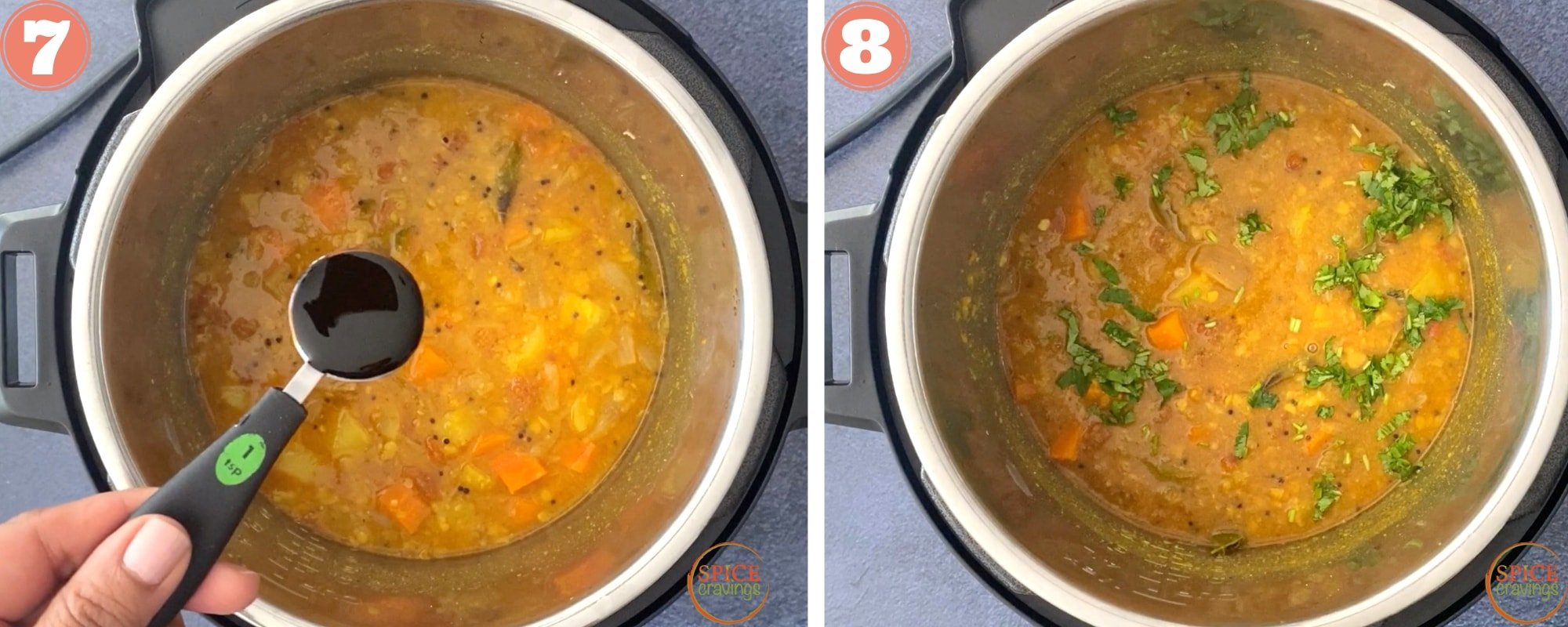
Alternative Method: Pot-in-Pot Vegetables
The method of mixing the vegetables in with the lentils will cook them until soft. However, if you like your veggies cooked, but not completely mushed with the lentils, use the pot-in-pot method to cook the vegetables. Simply:
- Add the ingredients for sambar, except the zucchini and carrots, in the Instant Pot steel insert as per directions above.
- Insert the trivet into the Instant Pot, then place a steamer basket on top and add veggies.
- Close the lid and pressure cook as directed.
- After the pressure is released, remove the lid. Take the steamer basket out carefully.
- Stir in tamarind concentrate and sugar (if adding). Using the back of a ladle or potato masher, mash the lentils to your desired consistency. Now add the steamed vegetables and check for seasoning. Let the curry rest for 2-3 minutes. Garnish with cilantro and serve.
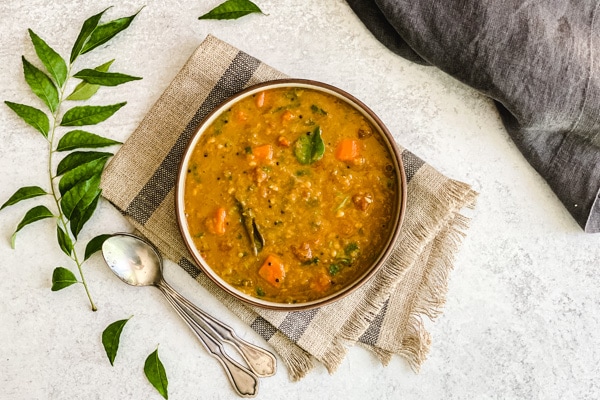
Serving Suggestions
Sambar is typically enjoyed with idli (steamed rice cakes), dosa (crisy crepes), rice or vada (fried lentil and rice donuts).
Idli-Sambar is one of my family's favorite Sunday brunch, so I always make a big pot of sambar along with my homemade idli/dosa batter. The following day I serve it with Uttapam 🙂
In India, it's considered one of the healthiest breakfast meals as it's packed with plant-based protein, vegetables and spices to get a jumpstart to your day.
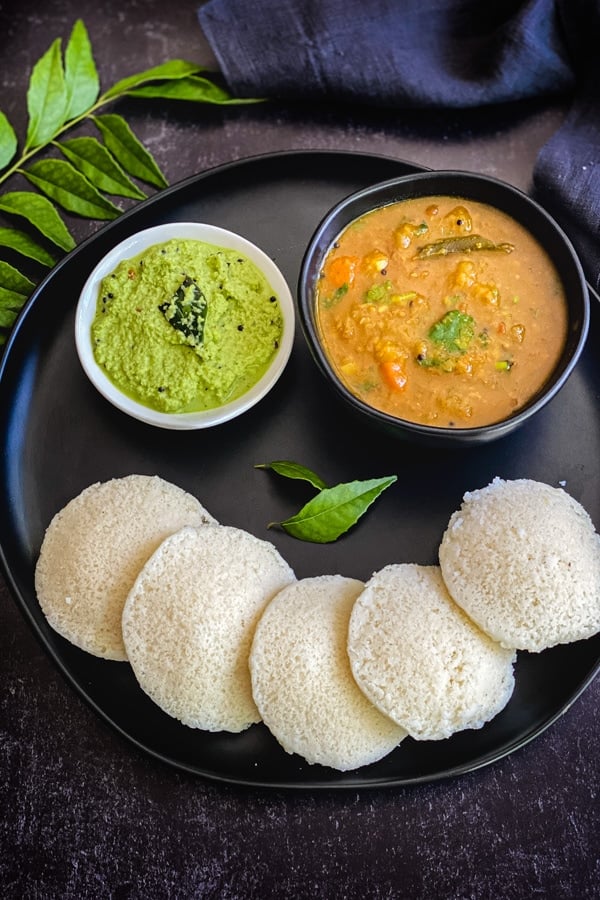
Vegetable Variations In Sambar
Sambar is made with mixed vegetables depending on the season. I chose zucchini and carrots for their light, summer flavor, but use 2 cups chopped vegetables of whatever you have on hand.
A few of my favorite variations are:
- Pumpkin and Green Beans: Cut the pumpkin into 1-inch cubes (you will need about 1 cup) and trim the green beans, then cut in half
- Eggplant and Okra: I recommend cubing and salting the eggplant 5 minutes beforehand to rid of its bitterness. Rinse and drain before adding to the Instant Pot, along with okra cut into 1-inch pieces
- Potatoes and Drumsticks: Dice a medium Yukon gold potato into 1-inch pieces and use 1 bag frozen drumsticks. Drumsticks, or moringa, is an Indian vegetable commonly used in sambar. Unlike most vegetables, when eating drumsticks, you only eat the inside pulp and discard the outer coating. The interior flesh and edible seeds taste like green beans, only sweeter. Look for it in the frozen food section of specialty Indian grocery stores.
Recipe Tips & Notes
- Adjust the amount of sambar powder to reach your desired level of spiciness. Use the mentioned amount of sambar powder for a medium spice level. Use 2 teaspoons for mild or increase to 1 ½ Tablespoons for spicy.
- Add sugar or jaggery for a sweet-and-sour kick. Although completely optional, I highly recommend adding a touch of sugar or jaggery (unrefined sugar made from sugar cane or palm) to offset the tamarind's sour flavor.
- Use a mix of vegetables when in season. Feel free to use any mix of 2 cups chopped vegetables such as pumpkin, green beans, eggplant, okra, potatoes or even Indian drumsticks (moringa) depending on the season.
- Store leftovers in the fridge or freezer. Sambar is best stored in an airtight container in the fridge for up to 4 days. Freeze into two plastic freezer storage bags or individual serving sizes for up to 1 month instead.
Commonly Asked Questions for Sambar
In a microwave-safe bowl, soak about 2 Tablespoons seedless tamarind in ¼ cup water and microwave on HIGH for 30 seconds. The tamarind will soften gently. Simply mix and scoop out 1 teaspoon. Store the remainder in a glass jar in the fridge.
More Instant Pot Lentil Recipes Like This
- Zesty Instant Pot Lentil Soup: One-pot lentil soup with Mediterranean and Middle Eastern flavors
- Instant Pot Dal Palak: Split lentils and baby spinach, tempered with ghee and warm Indian spices
- Dal Makhani in Instant Pot: Creamy, rich and flavor-packed black lentil and kidney bean curry
- Instant Pot Chana Dal: North Indian-style curry made with split chickpeas, onions, ginger, garlic and spices
- Instant Pot Dal Tadka: Split pigeon pigs flavored with aromatics and spices cooked pot-in-pot with basmati rice in under 30 minutes
- More Lentil recipes
★ Did you make this recipe? Please give it a star rating below! For more quick & easy recipes, FOLLOW ME on Facebook, Instagram, Pinterest and Youtube.
📖 Recipe
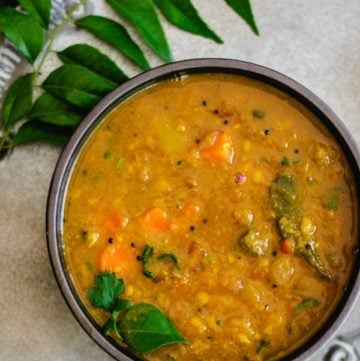
Instant Pot Sambar (Lentils & Vegetable Stew)
Equipment
Ingredients
- ½ cup toor dal split pigeon peas
- 1 tablespoon olive oil
- 1 pinch heeng asafetida
- 1 teaspoon black mustard seeds
- 12-15 curry leaves
- 1 medium onion chopped in ½-inch pieces
- ½ inch ginger minced (2 teaspoons)
- 2 garlic cloves minced (2 teaspoons)
- 1 cup chopped Roma tomatoes
- ¾ -1 teaspoon salt adjust to taste
- ½ teaspoon turmeric powder
- 1 tablespoon sambar powder reduce to 2 teaspoon for mild, or 1.5 tablespoon for spicy
- 1 teaspoon coriander powder
- 2 cups water
- 1 large zucchini cut in 1-inch pieces
- 1 large carrot cut in ½ inch pieces
For Finishing
- 1 teaspoon tamarind concentrate (adjust to taste)
- ¼- ½ teaspoon sugar or jaggery optional
- 2 tablespoons chopped cilantro
Instructions
Rinse & Soak
- Rinse and soak lentils in hot water while you prepare other ingredients.
Saute Aromatics and Pressure Cook
- Turn on Sauté on High. Add oil and heat for 30 seconds. Add heeng followed by mustard seeds.
- When mustard seeds begin to splutter, add curry leaves, onion, ginger, and garlic. Sauté for 3 minutes, until the onions soften a little.
- Add chopped tomatoes along with salt, turmeric, coriander and sambar powder.. Sauté for 2 minutes till the tomatoes break down. Add ¼-⅓ cup water and deglaze the pot. Scrape off any brown bits stuck to the bottom.
- Add rinsed and drained lentils along with the chopped vegetables. Add water and stir. Turn off Sauté.
- Lock lid in place in sealing position. Set pressure cook or Manual for 10 minutes at High Pressure on sealing mode. For a mushier texture, adjust time to 12 minutes. When the cooking time is up, let the pressure release naturally for 5 minutes, followed by a quick release as per your cooker instructions. Unlock and remove the lid.
Add Finishing Flavors
- Stir in tamarind concentrate, sugar (if adding) and check for seasoning. Using the back of a ladle or potato masher, mash the lentils to get a creamy texture. Let the curry rest for 2 to 3 minutes. Garnish with cilantro and serve with Steamed Basmati Rice.
Alternative Method: Pot-In-Pot Vegetables
- Add the ingredients for sambar, except the vegetables, in the Instant Pot steel insert as per directions above.
- Insert the trivet into the Instant Pot, then place a steamer basket on top and add veggies.
- Close the lid and pressure cook as directed.
- After the pressure is released, remove the lid. Take the steamer basket out carefully.
- Stir in tamarind concentrate and sugar (if adding). Using the back of a ladle or potato masher, mash the lentils to your desired consistency. Now add the steamed vegetables and check for seasoning. Let the curry rest for 2-3 minutes. Garnish with cilantro and serve.
Video
Notes
- Use the amount of sambar powder for a medium spice level. Or adjust the amount of sambar powder to reach your desired level of spiciness. Use 2 teaspoons for mild or increase to 1 ½ Tablespoons for spicy.
- Add sugar or jaggery for a sweet-and-sour kick. Although completely optional, I highly recommend adding a touch of sugar or jaggery (unrefined sugar made from sugar cane or palm) to offset the tamarind's sour flavor.
- Use a mix of vegetables when in season. Feel free to use any mix of 2 cups chopped vegetables such as pumpkin, green beans, eggplant, okra, potatoes or even Indian drumsticks (moringa) depending on the season.
- Store leftovers in the fridge or freezer. The lentil and vegetable soup is best stored in an airtight container in the fridge for up to 4 days. Freeze into two plastic freezer storage bags or individual serving sizes for up to 1 month instead.


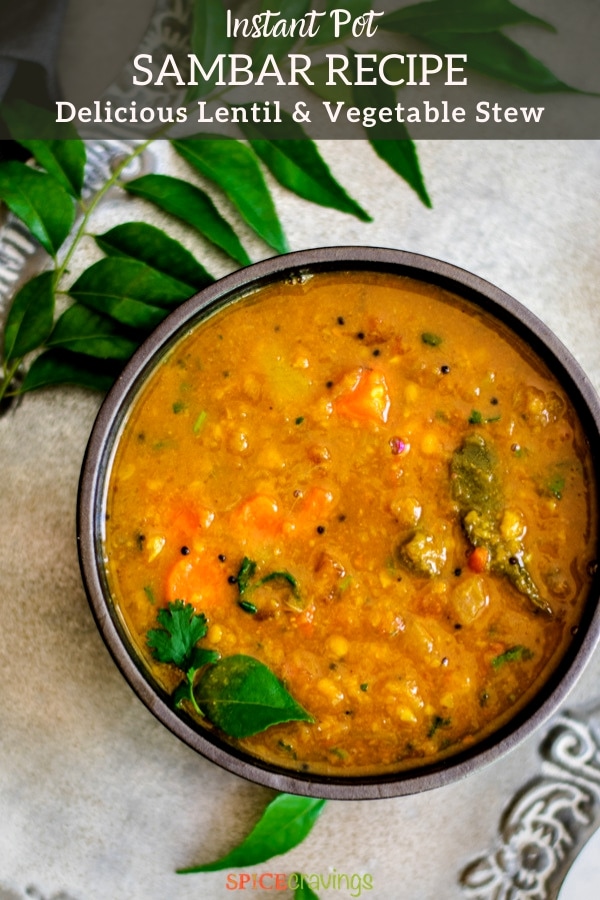
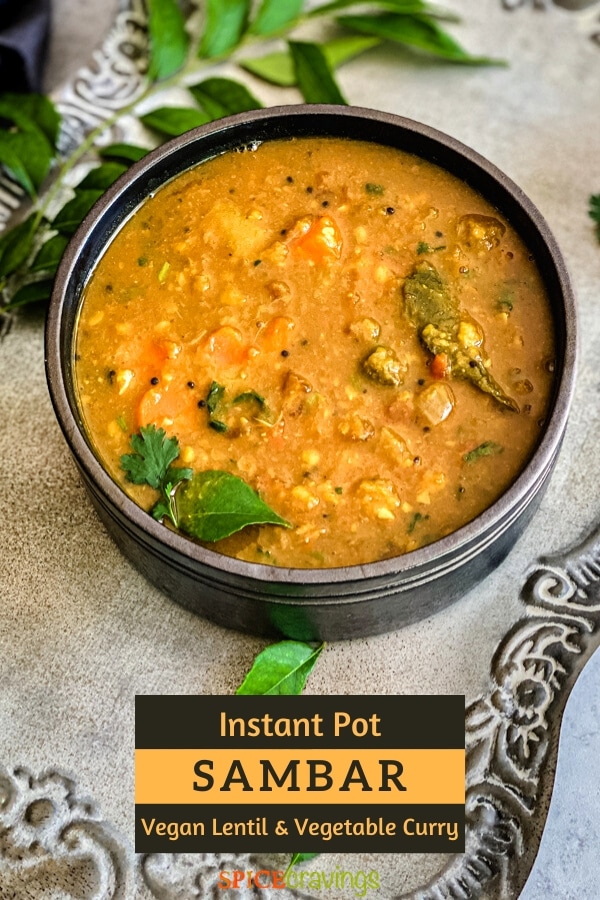
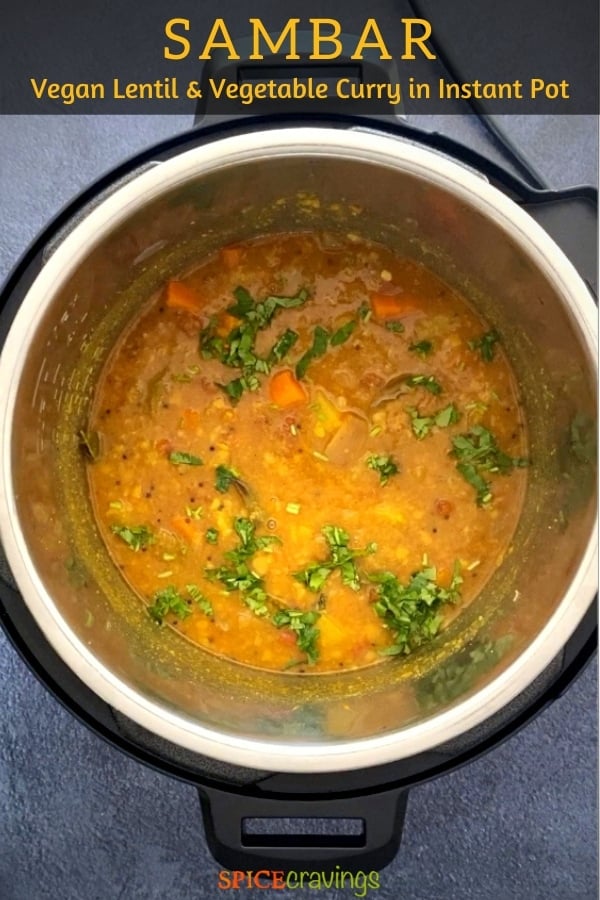
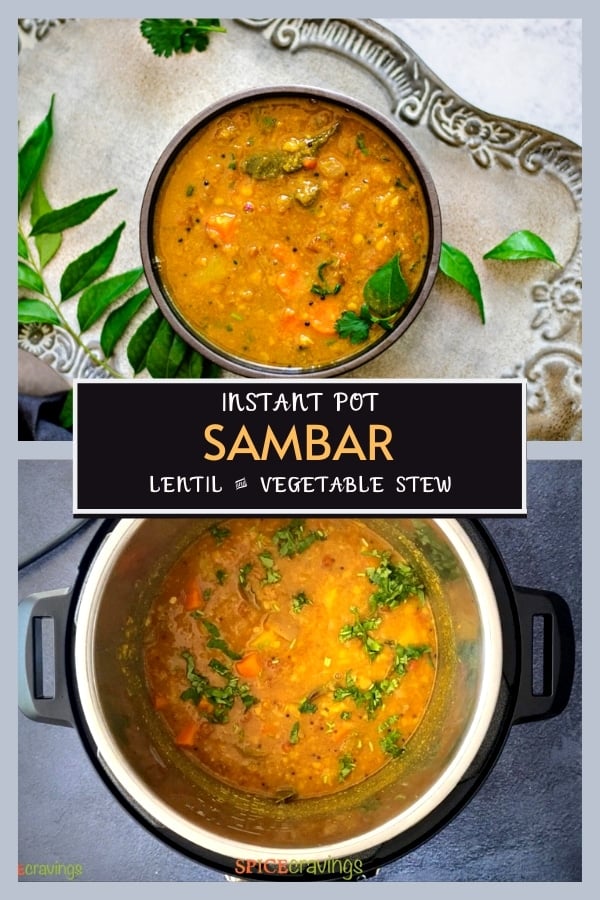
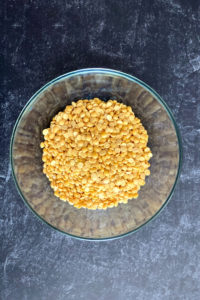
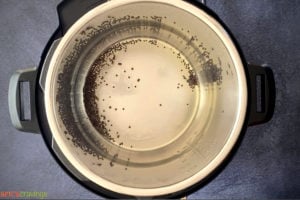
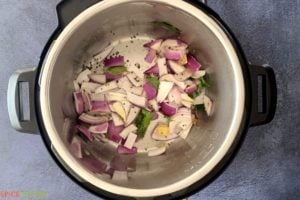
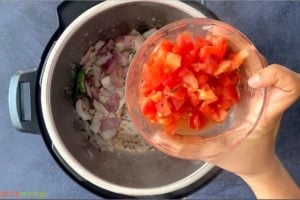
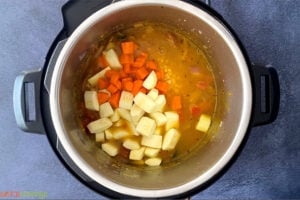

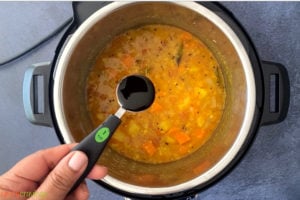
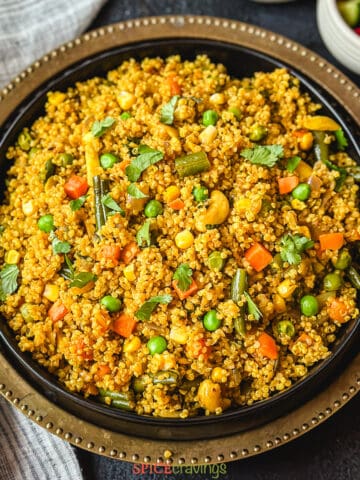
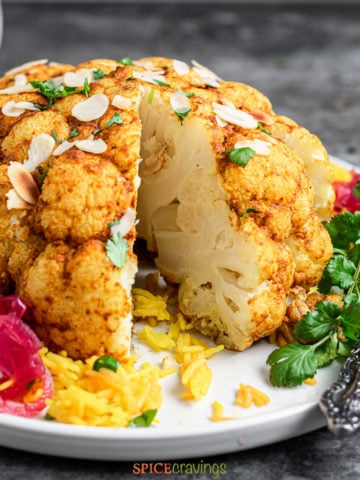

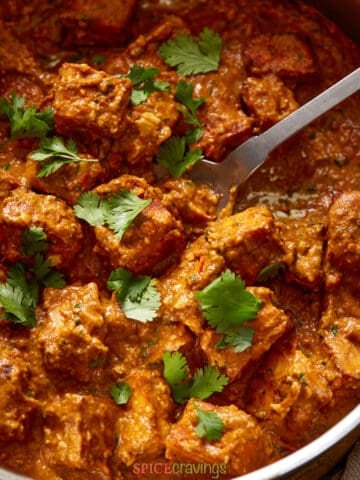

Alocasia says
Is there a substitute that can be used in place of the curry leaves? That's the only thing I don't have. This sounds amazing.
Aneesha says
Hi Alocasia, you could add 1 teaspoon lime zest if you have that, otherwise just skip altogether. I hope you enjoy it!
Matthew says
My toor dal never disintegrates. Is it because of the brand I bought?
Aneesha says
Hi Matthew, It could be the brand or maybe it's too old. Try pressure cooking for another 2-4 minutes and see if that works. If not, I recommend purchasing a new pack.
vishal says
Amazing! I love South Indian Food.Read More:- sambhar without tamarind
Aneesha says
Thank you, I'm so glad you enjoy it!
Rayna says
Can you blend the daal? My family likes things watery and smooth
Aneesha says
Hi Rayna, yes you can. I would recommend cooking the veggies in a steamer basket placed on a trivet, so they don't turn to mush when you blend the dal, unless you prefer it that way. Hope this helps
Priya S says
Tried this easy-to-follow recipe for a dinner party when my mom wasn't available to talk me through her own recipe. This one was delicious and a huge hit!!
Aneesha says
Hi Priya, what a sweet comment! I'm so glad you enjoyed this recipe. Thanks for your kind words and ratings!
SV says
Hi there
Very tasty recipe. Would you mind updating Step-3 or Step 4 in your instant pot recipe please. It’s missing the addition of spices / condiments. For beginners like me, who follow the recipe blindly 😬, it keeps us guessing what to do with those condiments now🤣 until One watches the video.
Anyways - thanks for posting this. My Family loved it! Thanks. Happy cooking 🤗!!
Aneesha says
Hi SV, thanks for pointing that out- will add that now. Thank you!